| Author |
Message |
Shahril Dzulkifli

|
 Posted: Sat 15 Dec, 2007 9:05 am Post subject: British 1796 Pattern Heavy Cavalry Sword Posted: Sat 15 Dec, 2007 9:05 am Post subject: British 1796 Pattern Heavy Cavalry Sword |
 |
|
Do you know that the British 1796 Pattern Heavy Cavalry Sword was modelled after the Austrian original from 1775? During the Napoleonic Wars this sword was used by the British Dragoon Guards in mounted warfare.
Perhaps I have never heard of British swords modelled after Austrian swords. Maybe there are lots more.

|
|
  |
 |
|
Jonathan Hopkins
|
 Posted: Sat 15 Dec, 2007 9:18 am Post subject: Posted: Sat 15 Dec, 2007 9:18 am Post subject: |
 |
|
Yes, the 1796 HC sword is modeled after the Austrian M1775, with a few changes. Here is a concise little page with some information and photos: Austiran M1775. I don't know of any other British regulation pattern swords that were based as directly on Austrian designs, except perhaps the Pattern 1788 Light Cavalry sword, but many nations were carrying similar patterns in the 18th century so it would be difficult to say that is based on an Austrian precursor.
Jonathan
|
|
  |
 |
|
Peter G.
Location: Bad Kreuznach/Germany Joined: 16 Nov 2007
Posts: 78
|
 Posted: Sat 15 Dec, 2007 2:48 pm Post subject: Posted: Sat 15 Dec, 2007 2:48 pm Post subject: |
 |
|
The M1796 HC was inspired by the austrian, the M1796 LC was designed by LeMarchant.
He saw the austrian cavalry 1793 in Flanders and thought the swords and the swordmen far superior to the english one.
His idea was to use the LC for both light and heavy cav., but this was denied by the horse guards-so the HC was designed.
The LC was one of the best cav. sabers ever created, the HC was ill balanced, far to short and heavy and with a blunt point unusable for thrusts-in contrary to the very good french ones.
I´ve handeld both M1796, the M1788 and the french counterparts.
The M1796 LC is a joy to handle (i own a officers-just 650gr) great for slashing and for thrusts-wunderful balance.
The HC is more a club then a sword-i like the look but not the handling.
M1788 feels ok but inferior in handling to the M1796.
The french ones are a joy-i own the ANIX LC-very agile, great balance, two sabre a bataille (Dragons/cuiraissiers)-one with a standart blade (1200gr) which is a little bit "pointheavy" but still handles far better then the english and a custom made with a shorter slimer blade (800gr) which feels absolutly weightless when handling-when handling blindfolded you wouldn´t belive there is a blade mounted.
The french sabre a chasseur (precedor to the ANIX) is about the size of the M1796 LC but more agile in handling.
All in all-the french handle better (and do look better;-) ) but i wouldn´t like to face the english either .
 Attachment: 64.38 KB Attachment: 64.38 KB
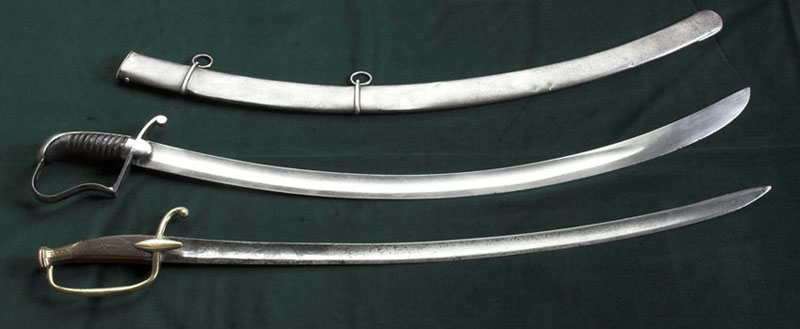
M1796LC and french infantry officers sabre
 Attachment: 67.76 KB Attachment: 67.76 KB
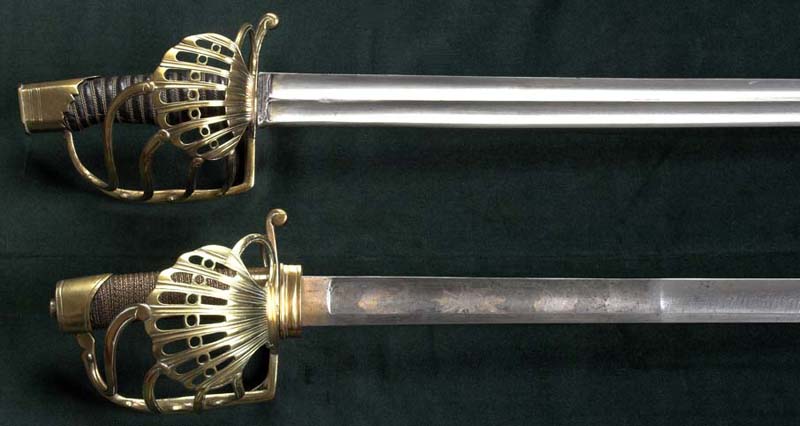
Sabre a bataille standart and custom made-hilts
 Attachment: 62.87 KB Attachment: 62.87 KB

Sabre a bataille standart and custom made
|
|
  |
 |
Shahril Dzulkifli

|
 Posted: Sun 16 Dec, 2007 8:52 am Post subject: British 1796 Pattern Heavy Cavalry Sword Posted: Sun 16 Dec, 2007 8:52 am Post subject: British 1796 Pattern Heavy Cavalry Sword |
 |
|
This is an Austrian Cavalry Broadsword from 1824. It is derived from both the British and Austrian heavy cavalry swords especially its handle.

|
|
  |
 |
|
Peter G.
Location: Bad Kreuznach/Germany Joined: 16 Nov 2007
Posts: 78
|
 Posted: Sun 16 Dec, 2007 9:43 am Post subject: Posted: Sun 16 Dec, 2007 9:43 am Post subject: |
 |
|
|
Its not a broadsword but a Pallasch :-) -straight blade with sabergrip
|
|
  |
 |
Shahril Dzulkifli

|
 Posted: Sun 06 Jan, 2008 3:54 pm Post subject: British 1796 Pattern Heavy Cavalry Sword Posted: Sun 06 Jan, 2008 3:54 pm Post subject: British 1796 Pattern Heavy Cavalry Sword |
 |
|
So that is an 1824 Austrian Cavalry Pallasch, not Broadsword. I am sorry. I didn't know that.
The British 1796 Pattern Heavy Cavalry Sword was made famous by the author Bernard Cornwell in his novel series about a 95th Rifles officer named Sharpe who carries this type of sword. Suggestions, everyone?
|
|
  |
 |
|
Lafayette C Curtis
|
 Posted: Thu 10 Jan, 2008 6:50 pm Post subject: Posted: Thu 10 Jan, 2008 6:50 pm Post subject: |
 |
|
|
It would certainly help if you can be more specific about what kind of suggestion you're soliciting....
|
|
  |
 |
|
Jonathan Hopkins
|
 Posted: Thu 10 Jan, 2008 7:26 pm Post subject: Re: British 1796 Pattern Heavy Cavalry Sword Posted: Thu 10 Jan, 2008 7:26 pm Post subject: Re: British 1796 Pattern Heavy Cavalry Sword |
 |
|
| Shahril Dzulkifli wrote: | | The British 1796 Pattern Heavy Cavalry Sword was made famous by the author Bernard Cornwell in his novel series about a 95th Rifles officer named Sharpe who carries this type of sword. |
Which is why I spent my summer earnings (1996) in in high school on this (even though the grip is awkwardly replaced):

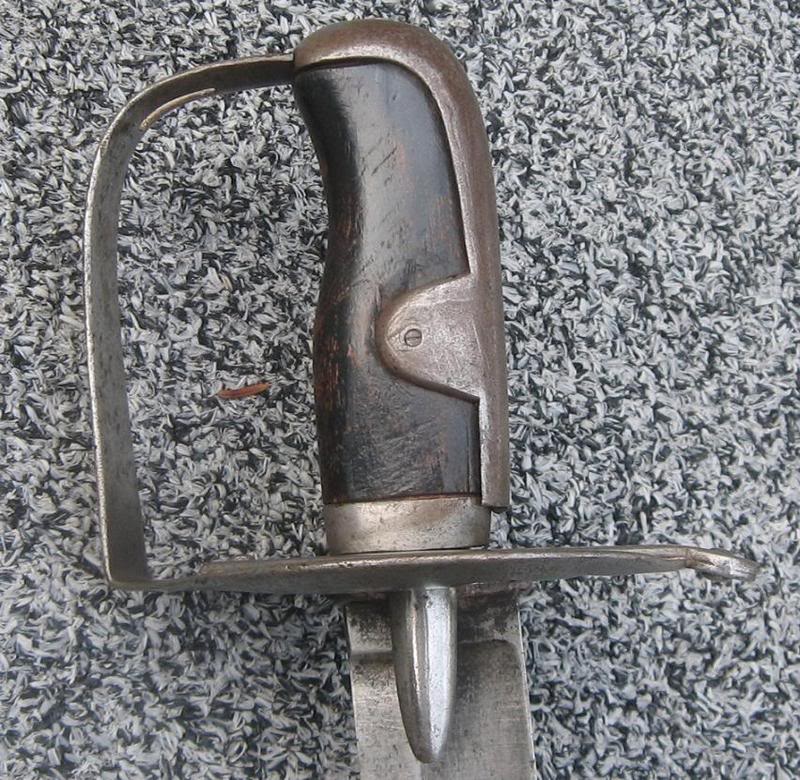
|
|
  |
 |
|
Dietrich Dellinger
|
 Posted: Thu 10 Jan, 2008 7:33 pm Post subject: Re: British 1796 Pattern Heavy Cavalry Sword Posted: Thu 10 Jan, 2008 7:33 pm Post subject: Re: British 1796 Pattern Heavy Cavalry Sword |
 |
|
| Shahril Dzulkifli wrote: | | The British 1796 Pattern Heavy Cavalry Sword was made famous by the author Bernard Cornwell in his novel series about a 95th Rifles officer named Sharpe who carries this type of sword. |
I think Jack Aubrey from Patrick O'Brian's Aubrey/Maturin novels used one as well.
|
|
   |
 |
D Critchley

|
 Posted: Sun 13 Jan, 2008 1:14 am Post subject: Re: British 1796 Pattern Heavy Cavalry Sword Posted: Sun 13 Jan, 2008 1:14 am Post subject: Re: British 1796 Pattern Heavy Cavalry Sword |
 |
|
| Dietrich Dellinger wrote: | | Shahril Dzulkifli wrote: | | The British 1796 Pattern Heavy Cavalry Sword was made famous by the author Bernard Cornwell in his novel series about a 95th Rifles officer named Sharpe who carries this type of sword. |
I think Jack Aubrey from Patrick O'Brian's Aubrey/Maturin novels used one as well. |
Jack uses the 1796 Light Cavalry sword like these, (if you'll forgive some gratuitous showing off a part of my collection):
At least that's what it implies in "The Commodore".
 Attachment: 24.85 KB Attachment: 24.85 KB
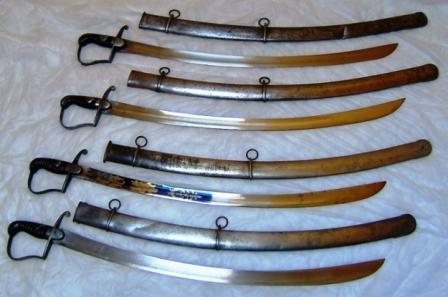
David C
"The purpose of the cavalry on the battlefield is to give tone to an event that otherwise might be considered a common brawl"
Last edited by D Critchley on Sun 13 Jan, 2008 4:35 am; edited 1 time in total
|
|
  |
 |
D Critchley

|
 Posted: Sun 13 Jan, 2008 4:22 am Post subject: Re: British 1796 Pattern Heavy Cavalry Sword Posted: Sun 13 Jan, 2008 4:22 am Post subject: Re: British 1796 Pattern Heavy Cavalry Sword |
 |
|
Just for clarity, there are 3 swords defined in the 1796 regulations as heavy cavalry swords:
The 1796 Trooper "disk hilt"
The 1796 Officer "ladder hilt"
The 1796 Officer "boatshell" dress sword
as below:
Both palache's have been spearpointed for campaign use. The disk hilt also has the "approved alteration" of having the near side of the disk ground back.
 Attachment: 92.02 KB Attachment: 92.02 KB
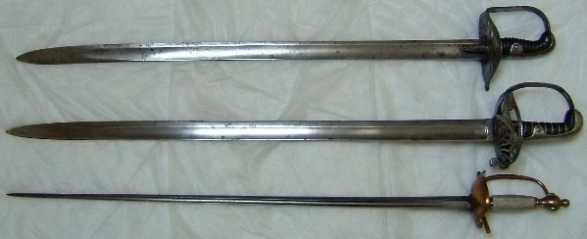
 Attachment: 69.53 KB Attachment: 69.53 KB
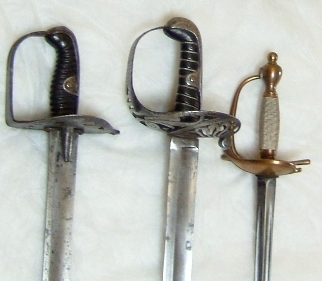
David C
"The purpose of the cavalry on the battlefield is to give tone to an event that otherwise might be considered a common brawl"
|
|
  |
 |
Shahril Dzulkifli

|
 Posted: Thu 07 Feb, 2008 4:47 pm Post subject: Re: British 1796 Pattern Heavy Cavalry Sword Posted: Thu 07 Feb, 2008 4:47 pm Post subject: Re: British 1796 Pattern Heavy Cavalry Sword |
 |
|
Here is a British P1796 Heavy Cavalry Troopers' Sword. The blade is straight with a single broad fuller to both sides to within 8" of the spear point and marked JOS. H. REDDELL & Co. on the back edge and has a British proof mark on the right side
The guard is a wrought iron knucklebow broadening out at the base into a pear shaped disc with a sword knot slot near the pommel and two langets on each side down the blade. The grip is wood bound with cord and covered in black leather with 08 painted in green on the iron back strap. The scabbard is iron with two loose ring swivels mounted on bands and has a narrow shoe. There are two Chinese characters painted in red on the reverse near the throat and it was captured by either British or Australian troops from the Boxers during the Boxer Rebellion in the 1900's in China.
 Attachment: 5.86 KB Attachment: 5.86 KB

 Attachment: 5.08 KB Attachment: 5.08 KB
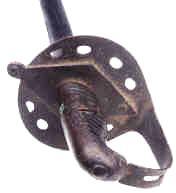
|
|
  |
 |
|
Jim McDougall
|
 Posted: Tue 13 May, 2008 8:15 pm Post subject: Re: British 1796 Pattern Heavy Cavalry Sword Posted: Tue 13 May, 2008 8:15 pm Post subject: Re: British 1796 Pattern Heavy Cavalry Sword |
 |
|
| Shahril Dzulkifli wrote: | Here is a British P1796 Heavy Cavalry Troopers' Sword. The blade is straight with a single broad fuller to both sides to within 8" of the spear point and marked JOS. H. REDDELL & Co. on the back edge and has a British proof mark on the right side
The guard is a wrought iron knucklebow broadening out at the base into a pear shaped disc with a sword knot slot near the pommel and two langets on each side down the blade. The grip is wood bound with cord and covered in black leather with 08 painted in green on the iron back strap. The scabbard is iron with two loose ring swivels mounted on bands and has a narrow shoe. There are two Chinese characters painted in red on the reverse near the throat and it was captured by either British or Australian troops from the Boxers during the Boxer Rebellion in the 1900's in China. |
Just reviewing the great posts over time here, and came across this.
What in the world were the Boxers doing with a British M1796 disc hilt!!!!
From all I have ever read , the Boxers were vehemently against using any weapon from 'foreign devils'.
I'd sure like to hear more on this one.
|
|
   |
 |
|
Jim McDougall
|
 Posted: Tue 13 May, 2008 8:17 pm Post subject: Re: British 1796 Pattern Heavy Cavalry Sword Posted: Tue 13 May, 2008 8:17 pm Post subject: Re: British 1796 Pattern Heavy Cavalry Sword |
 |
|
| Shahril Dzulkifli wrote: | Here is a British P1796 Heavy Cavalry Troopers' Sword. The blade is straight with a single broad fuller to both sides to within 8" of the spear point and marked JOS. H. REDDELL & Co. on the back edge and has a British proof mark on the right side
The guard is a wrought iron knucklebow broadening out at the base into a pear shaped disc with a sword knot slot near the pommel and two langets on each side down the blade. The grip is wood bound with cord and covered in black leather with 08 painted in green on the iron back strap. The scabbard is iron with two loose ring swivels mounted on bands and has a narrow shoe. There are two Chinese characters painted in red on the reverse near the throat and it was captured by either British or Australian troops from the Boxers during the Boxer Rebellion in the 1900's in China. |
Just reviewing the great posts over time here, and came across this.
What in the world were the Boxers doing with a British M1796 disc hilt!!!!
From all I have ever read , the Boxers were vehemently against using any weapon from 'foreign devils'.
I'd sure like to hear more on this one.
|
|
   |
 |
Bennison N

|
 Posted: Tue 13 May, 2008 8:33 pm Post subject: Posted: Tue 13 May, 2008 8:33 pm Post subject: |
 |
|
There's an old Chinese tradition about writing in red, names in particular... It means you're dead.
What are the characters? Do you have a picture of them? I'll tell you what they mean, if you like.
That could be a sword that killed a somebody... And was held on to, like a souvenir or a way to remember them.
"Never give a sword to a man who can't dance" - Confucius
अजयखड्गधारी
|
|
  |
 |
|
Jim McDougall
|
 Posted: Tue 13 May, 2008 11:54 pm Post subject: Posted: Tue 13 May, 2008 11:54 pm Post subject: |
 |
|
| Bennison N wrote: | There's an old Chinese tradition about writing in red, names in particular... It means you're dead.
What are the characters? Do you have a picture of them? I'll tell you what they mean, if you like.
That could be a sword that killed a somebody... And was held on to, like a souvenir or a way to remember them. |
Thats interesting Bennison! It recalls certain other cultures who had to carry out particular ceremonies with a weapon if it had killed, as it was considered tainted.
I'm still wondering what this Napoleonic British sword would have been doing in the hands of a Chinese individual during the Boxer Rebellion.
|
|
   |
 |
|
Jim McDougall
|
 Posted: Tue 13 May, 2008 11:55 pm Post subject: Posted: Tue 13 May, 2008 11:55 pm Post subject: |
 |
|
| Bennison N wrote: | There's an old Chinese tradition about writing in red, names in particular... It means you're dead.
What are the characters? Do you have a picture of them? I'll tell you what they mean, if you like.
That could be a sword that killed a somebody... And was held on to, like a souvenir or a way to remember them. |
Thats interesting Bennison! It recalls certain other cultures who had to carry out particular ceremonies with a weapon if it had killed, as it was considered tainted.
I'm still wondering what this Napoleonic British sword would have been doing in the hands of a Chinese individual during the Boxer Rebellion.
|
|
   |
 |
|
Mrak E.Smith
|
 Posted: Wed 14 May, 2008 12:36 am Post subject: Posted: Wed 14 May, 2008 12:36 am Post subject: |
 |
|
| Bennison N wrote: | There's an old Chinese tradition about writing in red, names in particular... It means you're dead.
What are the characters? Do you have a picture of them? I'll tell you what they mean, if you like.
That could be a sword that killed a somebody... And was held on to, like a souvenir or a way to remember them. |
Bennison,
I've indeed told by parents that do not write down Sb's name in red,but they didn't tell me why,maybe because the names of criminal sentenced to death are also writen in red(and then added a ampled blood red "√"),this is a tradition lasted untill my childhood .The official way of representing a passed man's name is add a pane around his name.
But who knows,I am an educated student,beliving nothing besides science,but the boxers were among the most blind-faithed zealots in chinese history ,they knew much more about gods,demons,sorcerys and they'll certainly use some kinds of curse,which is beyond my knowledge.
|
|
  |
 |
|
Jim McDougall
|
 Posted: Wed 14 May, 2008 9:33 am Post subject: Posted: Wed 14 May, 2008 9:33 am Post subject: |
 |
|
It would be great to see illustrations of these Chinese characters on the sword.
While we have determined the reasons why these might have been painted on the sword, I wonder if anyone else shares my curiosity about why a Napoleonic British disc hilt would be captured in China in 1900 ?
These swords have presented certain puzzling instances before, one being the famed Sharpe novels which have Sharpe who is in a Rifle regiment carrying one of these huge swords. Clearly this was literary license? or was it? It would appear these swords got around much more than previously thought!
After Waterloo, these were replaced by the M1821 heavy cavalry sabre, though they really didnt gain significant production until 1829 if I recall earlier reading on them. I believe that large numbers of these went into stores at the Tower, and it seems many were destroyed in a fire c.1850's. I'm relying on memory from reading long ago here, so please correct me.
The question is, why would a sword not particularly favored when in regulation use, turn up in China 75 years later in a cultural sphere which abhorred western weaponry?
|
|
   |
 |
|
Brian Nicholas
Location: Ohio, USA Joined: 14 May 2008
Posts: 17
|
 Posted: Wed 14 May, 2008 10:21 pm Post subject: Posted: Wed 14 May, 2008 10:21 pm Post subject: |
 |
|
Was reviewing old post as I just joined the forum and came across this. It caught my eye as I have a 1796 Light Cavalry pattern saber in my collection.
If memory serves, and it's been a while since I've read the novels, Sharpe carried the Heavy saber as it was a more substantial sword than what the Rifle Regiments and/or foot regiments used. I think his was a German blade, becasue he frequently visisted the campsite of the King's German Legion to have the armourer put an edge on the blade. You have to admit it is a substantial blade and something that big with a sharp edge would do terrific damage to a body. Sharpe is an irregular officer, not at all typical of British Offiers of the period, so it stands to reason he would have carried an atypical sword.
I will have to take some photos of my 1796 LC Saber and give you guys some stats and amrkings to see if anyone can help me ID it properly.
Have been collecting swords for 20 years. Have over a dozen historical and repro pieces.
|
|
  |
 |
|
|

